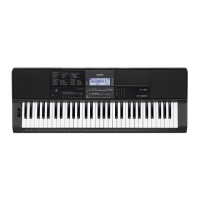
Do you have a question about the Casio CT-X800 and is the answer not in the manual?
| RMS rated power | 2.5 W |
|---|---|
| Speaker diameter | 12 mm |
| Number of speakers | 2 |
| USB connector type | USB Type-A, USB Type-B |
| Product color | Black |
| Tuning frequency | 415.5 - 465.9 Hz |
| Demo songs quantity | 1 |
| Preset programs quantity | 160 |
| Keys quantity | 61 keys |
| Power source type | DC |
| Depth | 350 mm |
|---|---|
| Width | 948 mm |
| Height | 109 mm |
| Weight | 4400 g |
Crucial guidelines for safe and proper product usage before initial operation.
Navigate menus and input values using number and +/- keys.
Restore the digital keyboard to its original factory settings for data and configurations.
Connect power via AC adaptor or batteries, and prepare the music stand.
Learn to turn on/off, adjust volume, and use headphones for basic keyboard use.
Adjust touch sensitivity, display contrast, and utilize the metronome.
Explore tone selection, layering, splitting, and tempo modification.
Choose from a wide variety of instrument sounds for your playing.
Combine two or three tones simultaneously for richer soundscapes.
Adjust the key that divides the keyboard into two different tone ranges.
Apply reverb for echo and chorus for depth and breadth to notes.
Adjust sound quality with equalizer and select pedal effects for performance.
Modify pitch in semitones, fine-tune frequency, or shift octaves for each tone part.
Use the wheel to smoothly alter note pitch for expressive effects.
Listen to pre-installed demo songs for enjoyment and practice.
Manage song playback using start/stop, pause, skip forward, and skip back functions.
Practice challenging sections by repeating specific measures within a song.
Modify playback tempo and adjust song volume for practice sessions.
Match keyboard tone to song and load external data to expand song library.
Play user song data directly from a USB flash drive.
Choose specific songs and practice individual hand parts or both.
Focus on timing by pressing any key to match flashing on-screen notes.
Follow three progressive lessons to learn and play songs accurately.
Practice songs entirely from memory without on-screen prompts.
Break down songs into short phrases for focused practice and mastery.
Customize lesson experience by turning off voice fingering and note guidance.
Turn off scoring and adjust phrase length for practice sessions.
Play the foundational rhythm part of auto accompaniment patterns.
Play chords with left hand to activate bass and harmony accompaniment.
Select how chords are recognized for auto accompaniment, e.g., CASIO CHORD, FINGERED.
Switch between normal and variation patterns for auto accompaniment.
Play intro, fill-in, and ending patterns to add musicality to accompaniment.
Control auto accompaniment start/stop with keyboard key presses for seamless play.
Turn the arpeggiator on/off and select arpeggio types.
Use looked-up chords to trigger auto accompaniment and display played chords.
Configure and save specific keyboard settings to registration memory banks.
Load previously saved keyboard configurations for immediate use.
Prevent specific settings from being overwritten when recalling registration data.
Record keyboard performances and play them back for review or practice.
Layer multiple keyboard performances onto a single recording.
Record keyboard input onto tracks 1 through 6 for multi-part performances.
Temporarily silence specific recorded tracks to focus on others.
Adjust recording track or song selection while in record standby.
Play along with and record keyboard performances during song lessons.
Remove recorded songs or individual tracks from memory.
Detailed list of functions accessible via FUNCTION button and their settings.
Adjust pitch, tempo, metronome, and volume settings for performance.
Configure reverb, chorus, and equalizer for tone modification and sound quality.
Manage scales, lesson guidance, performance evaluation, and phrase length.
Configure chord lookup, MIDI communication, and on-screen navigation guidance.
Adjust pitch bend range, pedal effects, auto power off, and display contrast.
Ensure selected scales are reflected in auto accompaniment playback.
Customize the appearance of the on-screen keyboard keys.
Follow steps to delete all data and return the keyboard to its initial factory state.
Overview of data types compatible with USB flash drive operations.
Insert, remove, and format USB flash drives for use with the keyboard.
Transfer songs, rhythms, and setups from USB to the keyboard's internal memory.
Save recorded songs, rhythms, and setups from the keyboard to a USB flash drive.
Remove unwanted files and data from the USB flash drive.
Change the names of files stored on the USB flash drive.
Link the keyboard to a computer via USB for MIDI data exchange.
Configure MIDI channels and set up on-screen navigation guidance.
Manage external sound sources and control auto accompaniment data output.
Transfer data using Data Manager, including downloading accompaniment data.
Connect keyboard to external audio equipment like amplifiers or speakers.
Connect portable audio players to the keyboard for playback through its speakers.
Minimize or mute vocals from audio input sources connected to the keyboard.
Address issues with power not turning on or display anomalies.
Resolve problems with note playback, accompaniment, song playback, and metronome.
Resolve issues with notes sounding continuously or settings changing unexpectedly.
Troubleshoot differences in sound quality across ranges or pitch mismatches.
Fix problems with skip operations and data exchange with computers.
Specifications for ports, power supply, battery life, and consumption.
Avoid adverse locations and follow proper cleaning procedures for the product.
Use specified accessories and observe etiquette for considerate use.
